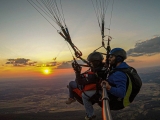If you've never dived before, now is the time to check out how to get a diving certification and experience this activity around the world. Can you imagine diving into South African waters?
Cape Town: The Great White Shark
Cape Town has recently become one of the most visited tourist destinations. The major draw is its cultural and geographical diversity, offering a wide range of experiences without the need to travel long distances.

Diving
Cape Town offers cold-water diving, particularly along the Atlantic coast, where temperatures below 10°C are common.
The incredible encounter with the Great White: Cage dives with this species take place in a channel between two uninhabited islands in Gansbaai. Trips run daily, chumming the water in anticipation of the big encounter. Once sharks appear, divers take turns in the cages for about 30 minutes. Due to the often-poor visibility, the spectacle is just as thrilling from the boat as inside the cage.

Cage diving is available almost year-round, though encounter rates vary by season, peaking from March to September.
Diving with seals
Dives with these playful creatures are exhilarating. A colony of countless seals lives on Duiker Island—they’ll approach divers to nibble fins and stare curiously with their big brown eyes. Perfect models for even the most demanding photographers.

Diving with penguins
Boulders Beach near Simon’s Town is home to a fascinating African penguin colony. This dive is suitable for all levels.
Accommodation: The most comfortable and budget-friendly option is a "bed & breakfast," where guests enjoy authentic South African hospitality. These are traditional houses with few rooms, each en-suite.

For luxury stays, Cape Town offers hotels of various categories, though they’re roughly 2 hours by road from Gansbaai (the dive site).
Aliwal Shoal & Protea Banks: The Indian Ocean
Aliwal Shoal lies 5 km from Umkomaas village and 60 km south of Durban.
Diving
These reefs stretch 3 km long and 300 m wide, delivering spectacular, adrenaline-fueled dives. Just the names of some sites hint at what awaits: "The Amphitheatre," "Shark Gully," "Shark Cave," "Lionfish Hole"...
Though rich in invertebrates (gorgonians, soft coral, sponges), the main attraction is the grey nurse sharks. A unique phenomenon is their winter cave congregations. On average, dives yield 10+ sharks (up to 50!), offering exceptional photo ops as divers can approach closely.

Northeast pinnacles rise to 2 m below the surface, while most reefs sit at 10–27 m. Famous for strong winds and sudden current shifts, all dives are drift-based, led by expert guides who know the reef intimately. These challenging conditions explain the many shipwrecks here.
For highly experienced divers, Protea Banks (recently discovered) offers thrilling encounters with sharks, pelagics, mantas, dolphins, marlin... The reef is riddled with caves and overhangs (25–60 m depths). Best diving is July–November. July–August sees grey nurse sharks gather to mate. August brings sardine runs, attracting copper sharks and hundreds of fish—a feast for hammerheads, Zambezi, and tiger sharks.

Accommodation: "Bed & breakfast" guesthouses provide a fun atmosphere and often better service than local hotels.
Sodwana Bay: The Mecca of South African Diving
Undoubtedly one of South Africa’s top dive regions, Sodwana draws 100,000 divers annually. Nestled in the Agulhas Current, its reefs nurture incredible biodiversity—around 1,200 fish species thrive in this marine reserve.

Diving
Sodwana’s reefs aren’t continuous but split into parallel ledges (15–30 m deep), coated in hard coral and sponges. Large schools of goatfish, groupers, morays, and rays are common. Visibility ranges 10–30 m.

Prime diving is November–June. In January, pregnant female grey nurse sharks arrive—calm and docile, often seen in big groups.
Accommodation: Sodwana Bay Lodge sits behind massive dunes facing a freshwater lake. The lodge blends into its scenic surroundings, with wooden walkways linking charming bungalows.











